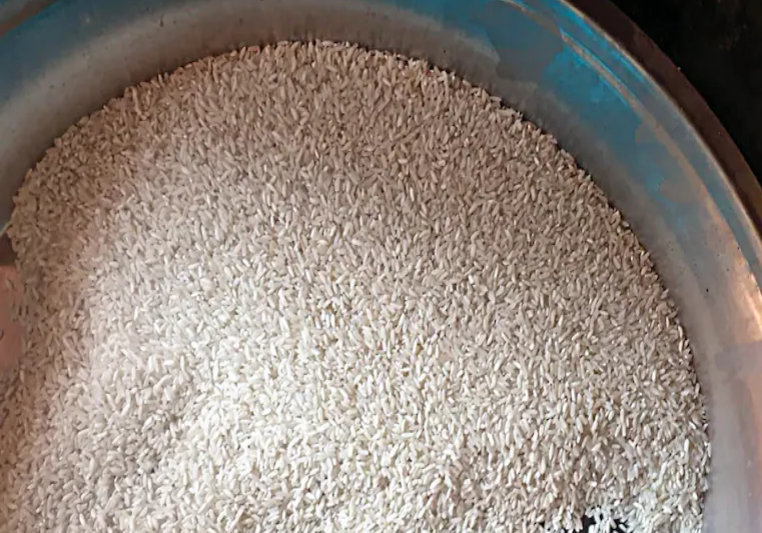
Making fortified rice a national standard is a well-intentioned move, but experts warn of the risks of overdosing on micronutrients
On India’s 75th Independence Day, Prime Minister Narendra Modi announced that the government will, by 2024, supply rice fortified with nutrients through the Public Distribution System (PDS) and food schemes targeting women and children. As a forerunner, to combat chronic anaemia and undernutrition, the Union ministry of consumer affairs, food & public distribution will distribute fortified rice through the Integrated Child Development Services (ICDS) Scheme and the Mid Day Meal Scheme (MDMS) from 2021-22, with a focus on 112 aspirational districts (those with poor socio-economic indicators). For this year, the Centre has allocated 32.8 million tonnes of rice for PDS, MDMS and the ICDS Scheme, under the National Food Security Act, 2013. But providing all of it as fortified rice by 2024 appears to be a tall task.
Rice fortification is enrichment of the cereal with micronutrients—commonly iron, Vitamin B12 and folic acid—to provide a nutritional boost to undernourished and vulnerable populations on a mega scale across geographies. According to Food Safety and Standards Authority of India (FSSAI) norms, a kilo of fortified rice will contain 28-42.5 mg of iron, 75-125 mcg of folic acid and 0.75-1.25 mcg of Vitamin B12 (see Super Rice).
India bears the largest burden of iron deficiency and anaemia globally, with nearly 59 per cent of children and 50 per cent of pregnant women anaemic, according to the National Family Health Survey (NFHS-4). Child and maternal malnutrition is responsible for 15 per cent of the country’s total disease burden. The NFHS-4, conducted in 2015-2016, found the prevalence of underweight, stunted and wasted children under five years of age to be 35.7, 38.4 and 21 per cent, respectively.
The Union government believes rice fortification is the panacea for malnutrition and has been working on ironing out supply chain and other logistical issues in consultation with the NITI Aayog, FSSAI and non-governmental stakeholders such as Tata Trusts, World Food Programme, PATH and Nutrition International. India produces over a fifth of the world’s rice. At a per capita consumption of 6.8 kilos a month, the country is the largest consumer of rice.
Rice fortification has been underway as a pilot scheme (one district per state) since 2019-20 in Andhra Pradesh, Maharashtra, Odisha, Uttar Pradesh, Gujarat, Tamil Nadu and Chhattisgarh, with plans to extend this to Madhya Pradesh, Telangana, Uttarakhand, Kerala and Jharkhand. Preliminary data suggests that fortified rice is well accepted by the beneficiaries.
Fortification is meant to improve the nutritional quality of food to bring health benefits to people with minimal risks. For this, food additives need to be used in permitted quantities. For example, iodised salt, introduced in 1962 to tackle goitre, has had wide acceptance in the country. However, expert opinion is divided on the health benefits of fortified rice.
DOES FORTIFIED RICE WORK?
Public health experts say food fortification is one of the most sustainable strategies to address micronutrient deficiencies in people. Not only is it cost-effective, scientifically proven and globally recognised, supplies to the targeted populations can be easily ensured through the ongoing food delivery schemes. Rice has the highest uptake in government food security programmes, such as PDS, ICDS Scheme and MDMS, potentially making it an ideal choice for fortification. It can help tackle the micronutrient deficiencies (‘hidden hunger’) that endanger the health of vulnerable sections of the population.
Women of reproductive age, children and adolescents are the most vulnerable. “Fortified rice can provide 30-50 per cent of the Recommended Dietary Allowance (RDA) of iron that adults need daily, based on average Indian consumption,” says Mini Varghese, country director, India, Nutrition International, one of the organisations partnering with the government on the pilot project. “Trials in a controlled setting, where 100 per cent RDA of iron was ensured, showed results within 10 months. But with fortified rice, you need a minimum of 24 months to see the impact.”
Nutrition International, in collaboration with the government’s Food Fortification Resource Centre (FFRC), conducted an acceptability study this February for fortified rice in three districts of Madhya Pradesh. Over 400 beneficiaries of the ICDS Scheme and MDMS were served khichdi and kheer prepared with fortified rice. More than 80 per cent of them liked it and over 60 per cent expressed interest in fortified rice if available through the PDS, MDMS and ICDS Scheme. Self-help groups (SHGs) in the three districts concluded that there was no visible difference between fortified rice and regular PDS rice nor any changes while washing and cooking it. “Multiple studies have shown the efficacy of fortified rice. More than 17 scientific publications in over 25 countries, including India, have demonstrated that consumption of extruded fortified rice is safe and effective in women and children. It can significantly address iron deficiency,” says Varghese.
A double-blind, placebo-controlled study in September 2011 by the Hyderabad-based National Institute of Nutrition in the adjacent Ranga Reddy district showed that regular intake of Micronised Ferric Pyrophosphate (MFPP) supplied through extruded fortified rice kernels reduces iron deficiency among schoolchildren. A double-blind study is a randomised trial in which neither the participants nor the experimenters know who all are part of the study.
A similar study in March 2012, conducted together by the St. John’s National Academy of Health Sciences, Bengaluru, and The Micronutrient Initiative (former name of Nutrition International), indicated that anaemia caused by iron deficiency had reduced from 30 per cent to 15 per cent among children who consumed fortified rice for seven months through a school mid-day meal programme in Bengaluru. The study showed that fortified rice (at 3-5 mg Fe per 100 g) was indistinguishable from natural rice, both in cooked and uncooked forms.
“Food fortification is a good move, but there is a long way to go before the results are visible,” emphasises Dr V. Prakash, president, International Union of Food Science and Technology, and former director, Central Food Technological Research Institute, Mysuru. “Rice is a staple food in many parts of India and can provide the required micronutrients on a daily basis along with other foods it is eaten with.This, hopefully, will be supplemented with enough proteins and other macro and micronutrients.”
LATENT HEALTH RISKS
Other experts say fortifying rice with one or two nutrients is not the answer to nutritional deficiencies since the other issue of ensuring sufficient amounts of quality protein in the diets of children and the convalescent remains. Experts also caution about the adverse impact of excess intake of micronutrients through food fortification.
Some point out that though the mandatory rice fortification programme is already being piloted in some districts, it focuses solely on the logistics without examining the intended benefits, such as alleviating anaemia. A perspective paper, published in The American Journal of Clinical Nutrition in July 2021, makes a strong case for improving dietary diversity instead. The study, which was led by Dr Anura V. Kurpad of the Department of Physiology, St. John’s National Academy of Health Sciences, argues for extreme caution because nutrients (like medicines) are beneficial in the right dose but potentially harmful when taken in excess.
The paper argues that there is over-estimating of anaemia and dietary iron deficiency in the country, primarily due to three factors—inappropriate haemoglobin cut-offs to diagnose anaemia in children or pregnant women; adoption of capillary (finger prick) blood sampling instead of venous sampling; and inflated daily iron requirement benchmarks, which have recently been corrected and revised down. “You don’t need to fortify to meet the daily requirement of 15-18 mg in the Indian diet. We need to consider whether we really have an iron-deficient diet, or, if we are not adequately absorbing iron, and if many other factors cause anaemia. Putting more and more iron into the diet places a part of the population at risk of breaching the tolerable upper limit of intake,” says Kurpad.
Kurpad terms mandatory rice fortification as a “knee-jerk reaction”. “It is well known since the past 20 years that higher intake of iron increases the risk of diabetes. We are already the diabetes capital of the world. The RDA is a wrong metric for population requirement. We should follow the revised NIN (National Institute of Nutrition) 2020 dietary recommendations, which is half of the RDA,” he says. “When we use it, many diets become magically adequate. People are not looking at the adequacy of dietary intake with the 2020 NIN recommendations. The corrected and apt population requirements can be met with a standard diverse diet.”
NOT EVERYONE NEEDS IT
The government’s plan is to mandatorily fortify rice and even edible oils with vitamins and minerals. Fortifying all rice through the country’s estimated 28,000 rice millers is a humungous exercise. India’s current capacity of producing 15,000 tonnes a year of fortified kernels is far from adequate to meet the ambitious target by 2024. The annual capacity needs to be in the range of 130,000 tonnes in order to cover the PDS, anganwadi and MDMS supplies in the 112 aspirational districts alone. To cover PDS across the country in 2024, at least 350,000 tonnes of fortified kernels will be needed.
The Food Corporation of India (FCI) has been asked to equip rice mills with blending machines needed to mix the kernels into regular rice. Rice millers will have to make the immediate investment and the government may consider offering loans and other incentives to create an enabling environment. Since the fortified kernels look and taste the same as regular rice grains, there is also a need for quality checks and monitoring to ensure that consumers are not taken for a ride. NABL (National Accreditation Board for Testing and Calibration Laboratories) and FSSAI laboratories are exploring how to build capacity for quality testing. Some of the other challenges are streamlining the supply chain of fortified rice in food programmes, installing adequate blenders at rice mills and training the millers and state and district officials.
Experts say mandatory fortification of rice will force even population groups that do not need it to take in the food additives. “Mandatory fortification of rice poses a food safety risk. The implementation of food safety laws is mainly left to states and Union territories; it is weak in several states,” says the international food safety specialist Dr Ramesh V. Bhat.
Those against food fortification argue that the total dietary intake of people from a variety of food sources, and not just rice, needs to be taken into account. Natural foods, such as locally available green vegetables and fruits, including a variety of berries found in the tribal and rural areas, could provide the deficient nutrients to the vulnerable groups. “Only a third of RDA can come from fortification; the rest has to be sourced from natural foods,” says Bhat.
Fortification is a preventive intervention and not a therapeutic one. It can help avert mild anaemia as a mid-term strategy and severe anaemia in the long run. There is overwhelming evidence in favour of complementing fortification with dietary diversification. “People take time to accept changes. A strong behavioural change communication strategy is required to create awareness about the health benefits of fortification and address the myths around it,” says Varghese. But, as Kurpad cautions, “The cure might become the malady.”





















